check engine AUDI R8 SPYDER 2012 Owner's Manual
[x] Cancel search | Manufacturer: AUDI, Model Year: 2012, Model line: R8 SPYDER, Model: AUDI R8 SPYDER 2012Pages: 236, PDF Size: 59.24 MB
Page 164 of 236
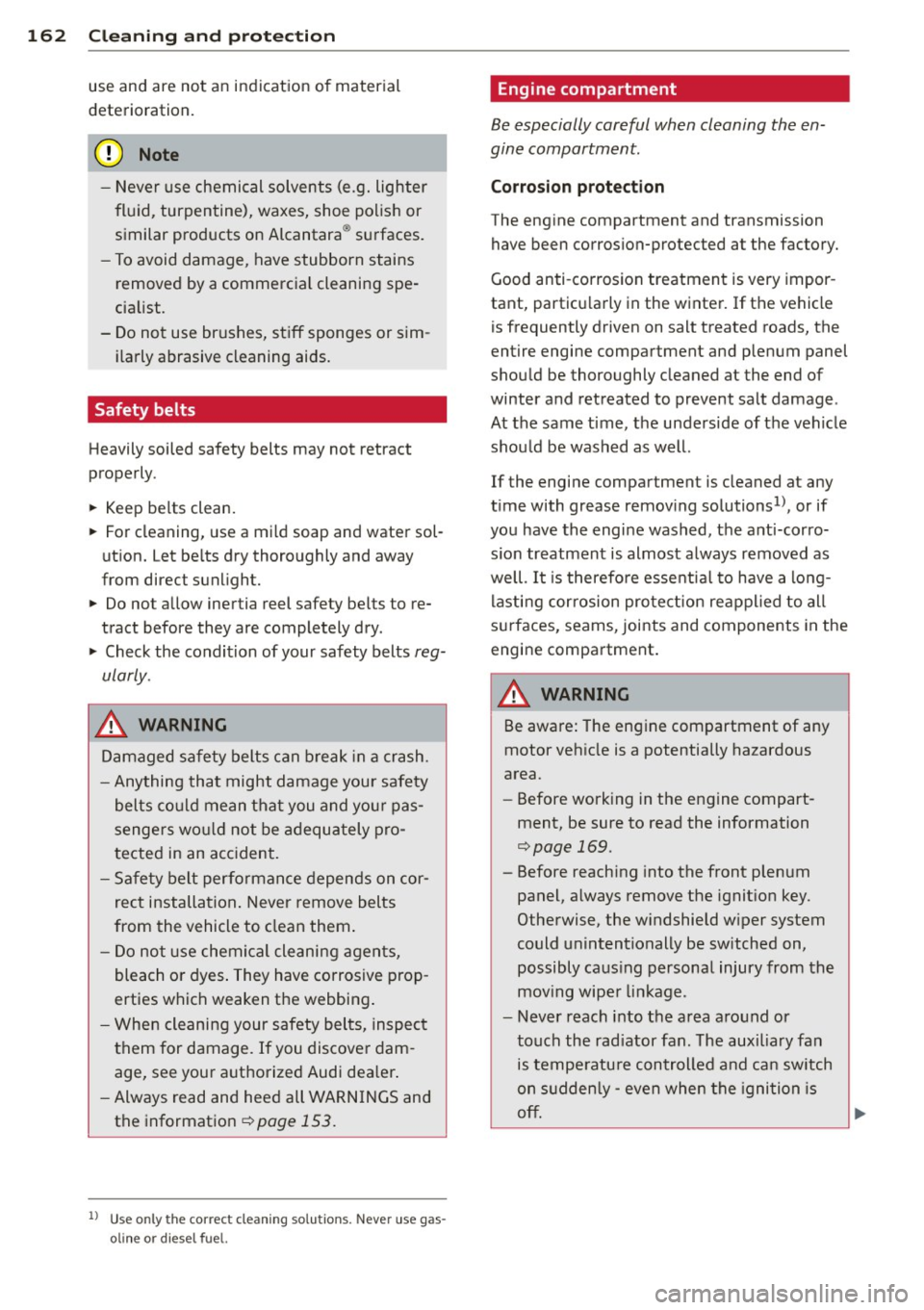
162 Cleaning and protection
use and are not an indication of material
deterioration.
(U;) Note
- Never use chemical solvents (e.g. lighter
fluid , turpentine), waxes, shoe polish or
similar products on Alcantara ® surfaces.
- To avoid damage, have stubborn stains
removed by a commercial cleaning spe
cialist.
- Do not use brushes, stiff sponges or sim ilarly abrasive cleaning aids.
Safety belts
Heavily soiled safety belts may not retract
properly.
• Keep belts clean.
• For cleaning, use a mild soap and water sol
ution. Let belts dry thoroughly and away
from direct sunlight.
• Do not allow inertia reel safety bel ts to re
tract before they are completely dry.
• Check the condition of your safety belts
reg
ularly .
_& WARNING
Damaged safety belts can break in a crash.
- Anything that might damage your safety
belts could mean that you and your pas
sengers would not be adequately pro
tected in an accident.
- Safety belt performance depends on cor
rect installation. Never remove belts
from the vehicle to clean them.
- Do not use chemical cleaning agents,
bleach or dyes. They have corrosive prop
erties which weaken the webbing.
- When cleaning your safety belts, inspect
them for damage. If you discover dam
age, see your authorized Audi dealer.
- Always read and heed all WARNINGS and
the information
¢page 153.
1) Use o nly the co rrect cle anin g so lu ti on s. Never use gas
o lin e or die se l fuel.
Engine compartment
Be especially careful when cleaning the en
gine compartment.
Corrosion protection
The engine compartment and transmission
have been corrosion-protected at the factory.
Good anti-corrosion treatment is very impor
tant, particularly in the winter.
If the vehicle
is frequently driven on salt treated roads, the
entire engine compartment and plenum panel
should be thoroughly cleaned at the end of
winter and retreated to prevent salt damage .
At the same time, the underside of the vehicle should be washed as well.
If the engine compartment is cleaned at any
time with grease removing solutions
1> , or if
you have the engine washed, the anti-corro sion treatment is almost always removed as
well.
It is therefore essential to have a long
lasting corrosion protection reapplied to all
surfaces, seams, joints and components in the
engine compartment.
A WARNING
Be aware: The engine compartment of any
motor vehicle is a potentially hazardous
area.
- Before working in the engine compart
ment, be sure to read the information
¢page 169.
-Before reaching into the front plenum
panel, always remove the ignition key .
Otherwise, the windshield wiper system
could unintentionally be switched on,
possibly causing personal injury from the
moving wiper linkage.
- Never reach into the area around or
touch the radiator fan. The auxiliary fan
is temperature controlled and can switch
on suddenly- even when the ignition is
off.
Page 171 of 236

Checking and filling Engine compartment
lid
Working in the engine compartment
Be especially careful whenever you work in the engine compartment!
Whenever you must perform any work in the
engine compartment, for example checking
and filling the different fluids, there is a risk
of injury, burns and accidents. To prevent per
sonal injury always observe the following
WARNINGS. The engine compartment of any
vehicle is a ha zardous area!
¢ &. .
_&. WARNING
To help avoid injury, before you check any
thing under the engine compartment lid:
- Switch off the engine.
- Remove the ignition key.
- Apply the parking brake.
- Move selector lever of R tronic to "N"
(Neutral); put manual transmission in
Neutral.
- Always let the engine cool down. Hot
components will burn skin on contact.
- To reduce the risk of being burned, never
open the engine compartment lid if you
see or hear steam or coolant escaping
from the engine compartment. Wait un
til no steam or coolant can be seen or heard before carefully opening the en
gine compartment lid.
- Keep children away from the engine com
partment .
- Never spill fluids on hot engine compo
nents. They can cause a fire.
- Never open the coolant reservoir cap
when the engine is still warm. The cool
ant system is pressurized and hot cool
ant could spray out .
- Protect your face, hands and arm from
steam or hot engine coolant by placing a
thick rag over the cap when you open the
coolant reservoir .
Checking and filling 169
-If work on the fuel system or the electri
cal system is necessary:
- Always disconnect the battery.
- Never smoke or work near heaters or open flames . Fluids in the engine com
partment could start a fire.
- Keep an approved fire extinguisher im
mediately available .
- To avoid electrical shock and personal in
jury while the engine is running or being started, never touch:
- Ignition cables
- Other components of the high voltage
electronic ignition system.
- If you must perform a check or repair
with the engine running:
- First, fully apply the parking brake,
move selector lever of R tronic to "N"
(Neutral); put manual transmission in
Neutral.
- Always use extreme caution to prevent clothing, jewelry, or long hair from get
ting caught in the radiator fan, V-belts
or other moving parts, or from contact
ing hot parts. Tie back hair before
starting, and wear no clothing that will
hang or droop into the engine.
- Minimize exposure to emission and
chemical hazards¢& .
A WARNING
California Proposition 65 Warning:
- Engine exhaust, some of its constituents,
and certain vehicle components contain
or emit chemicals known to the State of
California to cause cancer and birth de
fects and reproductive harm. In addition,
certain fluids contained in vehicles and
certain products of component wear con
tain or emit chemicals known to the State of California to cause cancer and birth defects or other reproductive harm.
- Battery posts, terminals and related ac
cessories contain lead and lead com
pounds, chemicals known to the State of
California to cause cancer and reproduc
tive harms. Wash hands after handling.
•
•
Page 172 of 236

1 7 0 Che cking and filling
(D Note
When adding fluids, a lways make sure that
they are poured into the proper container or filler opening, otherwise serious dam
age to veh icle systems will occur.
@ For the sake of the environment
To detect leaks in time, inspect the vehicle
floor pan from underneath regu larly . If
you see spots from oil or other vehicle flu ids, have your vehicle inspected by an au
thorized Audi dealer.
Releasing the engine compartment lid
The engine compartment lid is released from
inside the vehicle .
Fig. 137 Driver's side: releasing t he engine co mpart
ment lid
Requirement : The ignition must be switched
on.
... Make sure the rear spoiler is retracted
¢page 144 .
... Pull the button @. The eng ine compart
ment lid opens slightly .
... Open the engine compartment lid
c> ,& .
A WARNING
-
Hot engine coo lant can burn you . To re
duce the risk of being bu rned, never open
the engine compartment lid if yo u see or
hear steam or coolant escaping from the
eng ine compartment. Wait until no steam
or coolant can be seen or heard before
carefully opening the engine compartment
lid.
(D Note
To prevent damage to the vehicle, on ly
open the engine compartment lid when
the convert ible top storage bay lid is
closed.
(D Tips
An emergency re lease can be used if the
engine compartment lid cannot be re
leased with the button
® ¢ page 171.
Closing the engine compartment lid
... Make sure that the rear spoiler is retracted
Qpage 144.
.,. Pull the eng ine compartment lid down unti l
the pressure from the struts is reduced .
... Press the engine compartment lid closed
Q&. .
A WARNING
A engine compartment lid that is not com
plete ly latched could fly up and b lock your
view wh ile driving.
- When you close the engine compartment
lid, check it to make sure the safety catch
has properly engaged. The engine com
partment lid should be flush with the
surrounding vehicle body parts.
- If you notice while driving that the en
gine compartment lid is not secured
properly, stop at once and close it.
Page 173 of 236
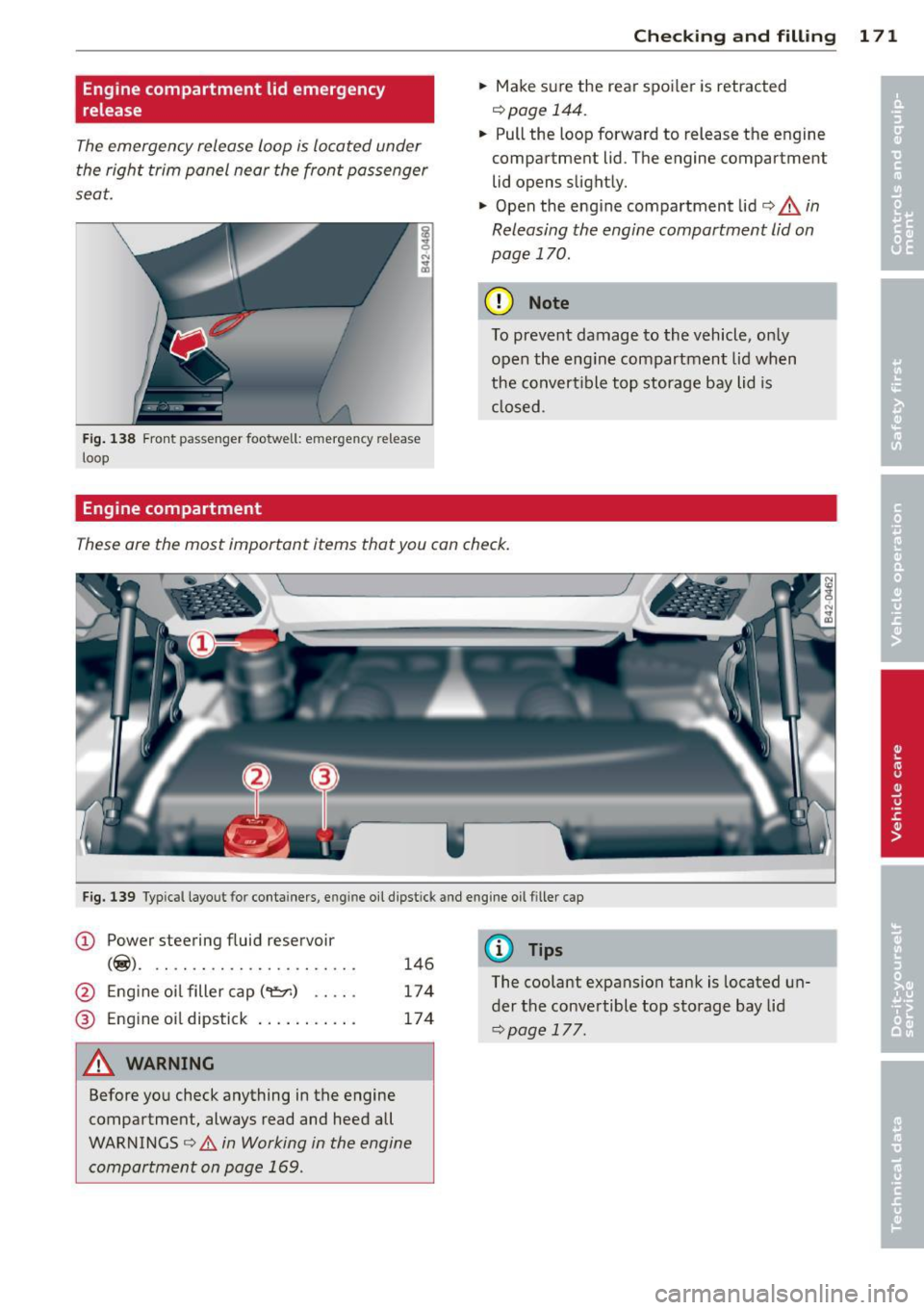
Engine compartment lid emergency
release
The emergency release loop is located under
the right trim panel near the front passenger
seat.
F ig . 138 Front pas se n ge r footwe ll: emer gen cy re lease
l oo p
Engine compartment
Checkin g and fillin g 171
.. Make su re the rear spoiler is retracted
¢ page 144 .
.. Pull the loop forward to release the engine
compartment lid . The engine compartment
lid opens sligh tly.
.. Open the engine compartment lid¢.&.
in
Releasing the engine compartment lid on
page 170.
(D Note
To prevent damage to the vehicle, only
open the eng ine compartment lid when
the convertible top storage bay lid is
closed .
Th es e ar e th e most important it ems that you can ch eck.
Fig. 139 Ty pical layout for containers , en gin e oil dipst ick and eng ine o il filler cap
(D Power steering fluid reservoir
(@) ... .. .... .... ... ...... .
@ Eng ine oi l filler cap ('l=r.) .. ...
® Engin e oi l dipstick
146
174
174
A WARNING
Before you check anything in the engine
compartment, always read and heed all
WARNINGS ¢.&. in Working in the engine
compartment on page 169 .
-
{!) Tips
The coolant expansion tank is located un
der the convertible top storage bay lid
¢ page 177.
Page 174 of 236
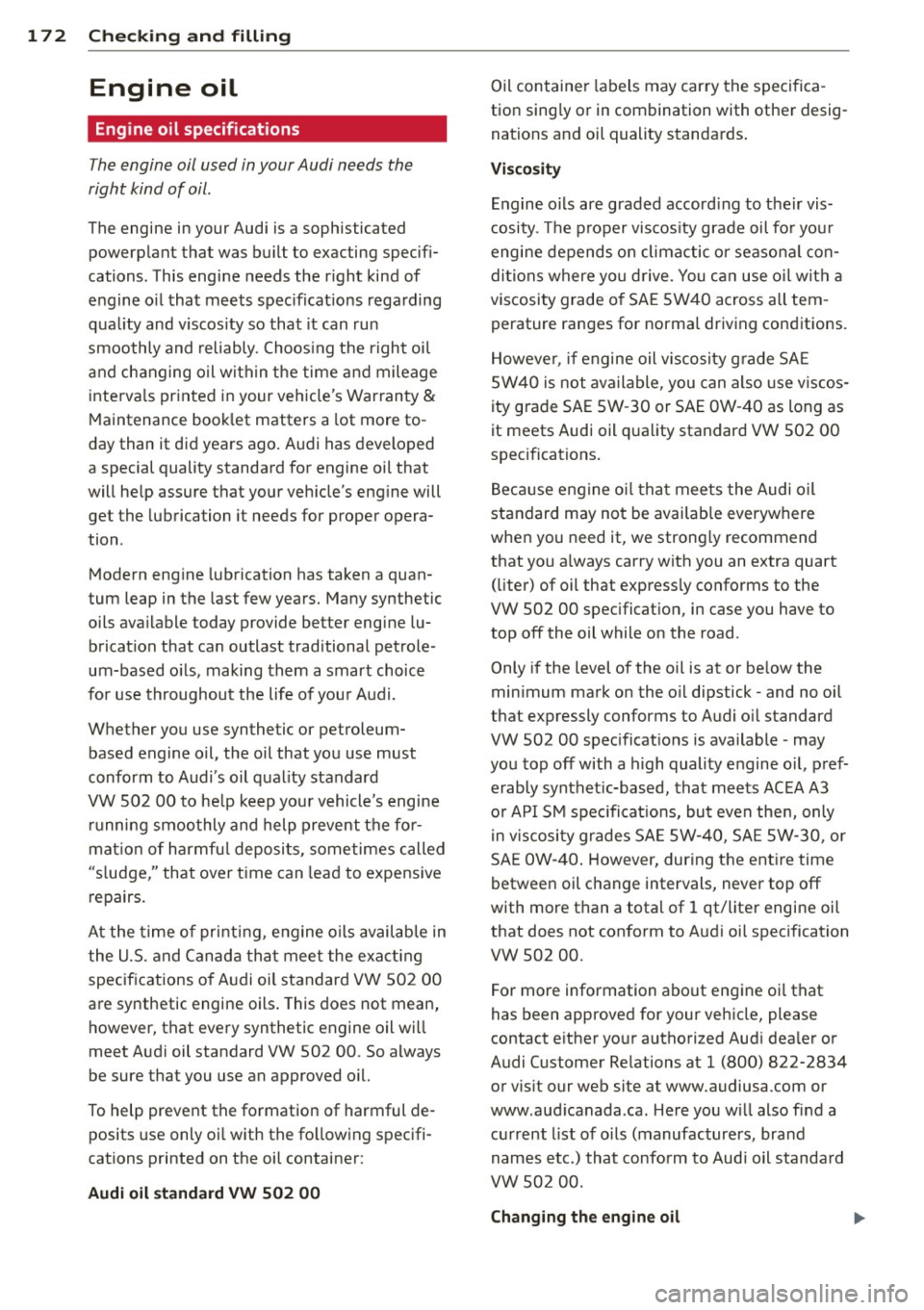
172 Checking and filling
Engine oil
Engine oil specifications
The engine oil used in your Audi needs the
right kind of oil.
The engine in your Audi is a sophisticated
powerplant that was built to exacting specifi
cations. This engine needs the right kind of
engine oil that meets specifications regarding
quality and viscosity so that it can run
smoothly and reliably. Choosing the right oil
and changing oil within the time and mileage intervals printed in your vehicle's Warranty
&
Maintenance booklet matters a lot more to
day than it did years ago. Audi has developed
a special quality standard for engine oil that
will help assure that your vehicle's engine will
get the lubrication it needs for proper opera
tion .
Modern engine lubrication has taken a quan
tum leap in the last few years. Many synthetic
oils available today provide better engine lu brication that can outlast traditional petrole
um-based oils, making them a smart choice
for use throughout the life of your Audi .
Whether you use synthetic or petroleum based engine oil, the oil that you use must
conform to Audi's oil quality standard
VW 502 00 to help keep your vehicle's engine running smoothly and help prevent the for
mation of harmful deposits, sometimes called
"sludge," that over time can lead to expensive
repairs.
At the time of printing, engine oils available in
the U.S. and Canada that meet the exacting
specifications of Audi oil standard VW 502 00
are synthetic engine oils. This does not mean,
however, that every synthetic engine oil will
meet Audi oil standard VW 502 00 . So always
be sure that you use an approved oil.
To help prevent the formation of harmful de posits use only oil with the following specifi
cations printed on the oil container :
Audi oil standard VW 502 00
Oil container labels may carry the specifica
tion singly or in combination with other desig nations and oil quality standards.
Viscosity
Engine oils are graded according to their vis
cosity . The proper viscosity grade oil for your
engine depends on climactic or seasonal con
ditions where you drive. You can use oil with a
viscosity grade of SAE SW40 across all tem
perature ranges for normal driving conditions.
However, if engine oil viscosity grade SAE
SW40 is not available, you can also use viscos
ity grade SAE SW-30 or SAE OW-40 as long as
it meets Audi oil quality standard VW 502 00
specifications.
Because engine oil that meets the Audi oil
standard may not be available everywhere
when you need it, we strongly recommend
that you always carry with you an extra quart (liter) of oil that expressly conforms to the
VW 502 00 specification, in case you have to
top off the oil while on the road.
Only if the level of the oil is at or below the
minimum mark on the oil dipstick - and no oil
that expressly conforms to Audi oil standard
VW 502 00 specifications is available -may
you top off with a high quality engine oil, pref
erably synthetic-based, that meets ACEA A3
or API SM specifications, but even then, only
in viscosity grades SAE SW-40, SAE SW-30, or
SAE OW-40. However, during the entire time
between oil change intervals, never top off
with more than a total of 1 qt/liter engine oil
that does not conform to Audi oil specification
vw 502 00.
For more information about engine oil that
has been approved for your vehicle, please
contact either your authorized Audi dealer or
Audi Customer Relations at 1 (800) 822-2834 or visit our web site at www.audiusa.com or
www .audicanada .ca. Here you will also find a
current list of oils (manufacturers, brand
names etc.) that conform to Audi oil standard
vw 502 00.
Changing the engine oil
Page 175 of 236

The engine oil and oil filter must be changed
according to the mi leage (kilometers) and
time interva ls specified in your vehicle's War
ranty
& Maintenance booklet. Do not exceed
t hese intervals -harmful deposits from old
engine o il can reduce engine performance and
can lead to expensive engine repairs .
Changing the o il at the recommended inter
vals is so very important because the lubricat
ing properties of oil decrease gradually during
norma l vehicle use . If you are not sure when
you have your oi l changed, ask your author
i zed A udi Service Advisor.
Under some circumstances the engine o il
should even be changed more frequently .
Change o il more often if you drive mostly
short distances, ope ra te the vehicle in dusty
areas or mostly under s top -and-go traffic con
d itions, or when yo u use your vehicle whe re
temperatures stay below freezing point for
l ong periods.
D etergen t additives i n the o il w il l make fresh
oil look dark after the eng ine has been run
ning for a short time . This is norma l and is not
a reason to change the oi l more often than
recommended.
Damage or malfunction s due t o lack of
m aintenance
It is essen tial that you change your oil at the
r ecommended inte rva ls using only engine o il
that complies with A udi oil standard
VW 502 00 . Your Limited New Vehicle War
ranty does not cover damage or malfunctions
d ue to fai lure to fo llow recommended mainte
nance and use req uirements as set forth in
t he Audi Owner's Manua l and Warranty
&
Ma intenance book let . Your authorized Aud i
deale r will have to deny warranty coverage un
l ess you present to the dealer p roof in the
fo rm of Se rvice o r Repair Orde rs t hat all
sched uled main tenance w as performed in a
time ly manner .
Checkin g and fillin g 173
Engine oil consumption
The engine in your vehicle depends on an ade
quate amount of oil to lubricate and cool all
of its moving parts .
In order to provide effective lubrication and
cooling of interna l eng ine components, all in
te rnal combust io n engines consume a certain
amount of oil. Oil consumpt io n va ries from
engine to engine and may change sig nifican tly
ove r the life of the engine. Typically, engines
with a spec ified break -in pe riod (see
¢
page 150) consume more oil duri ng the
break-in pe riod than they consume afte r oi l
consumption has stabili zed.
U nder normal cond itions , the rate of oi l con
s u mption depends on t he q uality and viscos ity
of the oil, the RP M (revolut ions per minute) at
which the engine is operated, the ambient
temperature and road conditions. Further fac
tors are the amount of oil dilut ion from water
condensa tion or fue l residue a nd the oxida
tion level of the oi l. As any eng ine is subject to
wear as mileage builds up, t he oil co nsump
t ion may incre ase over time until repla cement
of wo rn components may be come necessary.
With a ll these va riab les coming into p lay, no
standard rate of oil consumpt io n can be es
t a bl is h ed o r spe cified . There is no alte rnative
to regular an d frequent chec king of the o il lev
el , see
Note.
If the yellow engine o il level wa rning symbo l
i n the instrument cluster
Ill lights up, yo u
sho uld check the oil leve l as soon as possib le
¢
page 174 . Top off the oil at your ear liest
convenience
¢ page 174.
A WARNING
-Before you check anything in the engine
c o mpartment, always read and heed a ll
WARNINGS¢
& in Working in the engine
compartment on pag e 169 .
(D Note
Driving w ith an insufficient o il level is like-
-
ly to cause severe damage to the engine. Ill>-
•
•
Page 176 of 236

17 4 Che cking and filling
@ Tips
If you have the impression your eng ine
consumes excessive amounts of oil, we
recommend that you cons ult your a uthor
ized Audi deale r to have the cause of yo ur
concer n properly d iagnosed . Keep in m ind
that the accurat e measurement of oil con
sumpt ion re quires great care an d may take
s ome time. Your author ized Audi dealer
h as ins truction s about h ow to mea sure o il
consumption a ccurately .
Checking the engine oil level
Fig. 140 Ins trume nt clus te r: En gin e o il te mpe rat ure
di sp lay
F ig.
14 1 Marke rs on oil dipstic k
Before you check anything in the eng ine com
pa rtment,
alway s read and heed all WARN
INGS ¢ A in Working in the engin e compart
ment on page 169.
Determining oil lev el
.. Warm up the engine by dr iv ing unt il t he in
strument cl uster d isplay shows an oil tem
perature of 210 °F (100 °C) to 230 °F
(110 °C)
¢ fig . 140 @ .
.. Park your vehicle so that it is hori zo ntally
level. ..
Allow the warm engine to r un for abo ut two
m inutes at idle.
.. Shut the eng ine off and wa it two minutes .
.. Check the oil level on the engine oil d ipstick
¢fig. 141.
Oil level within range (v
.. Do not add oil.
Oil level within range@
"" Add 1 quart (I liter) of oi l i=:> page 174. Af
terwards ,
the oil leve l sho uld be with in
r a nge
G) .
Depend ing on the way the vehicle is dr iven
and the ope ra tin g cond itions, o il consu mption
ca n be up to 1 q uart per 600 miles (1 liter per
1,0 00 km) . Co nsump tion may be higher with
i n the f irst 3,000 mi les (5,00 0 km) .
Adding engine oil~
Fig. 14 2 En g in e co mpa rt m ent: O il fil ler cap loca tio n
Befo re you check a nyth ing in the eng in e com
partment,
always read and heed all WARN
INGS ¢.&. in Working in the engine compar t
men t on page 169.
.,. Unsc rew th e cap 't=;,1 to the eng ine o il filling
hole
¢ fig . 14 2.
.,. Care fully top o ff wi th t he a ppropr iate oil
¢ page 217.
.. Check the oil level again ¢ page 174 .
.. Top off the oi l aga in, if necessary .
.,. Sc rew the cap back on the filling hole and
slide the oil dipstick in as far as it w ill go. ..,.
Page 177 of 236
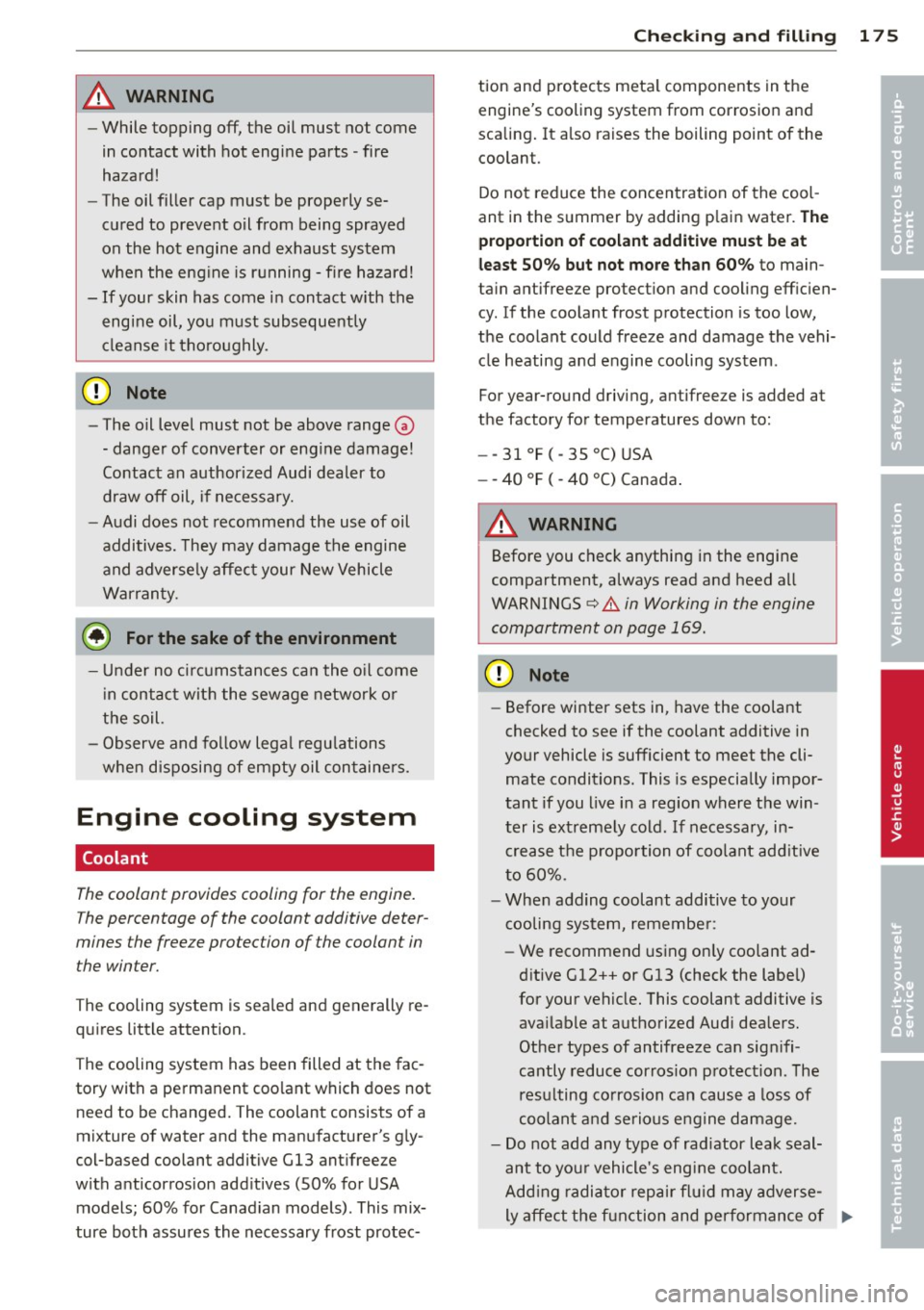
A WARNING
-While top ping off, the oil must not come
in contact with hot engine pa rts -fire
hazard!
- The oil fille r cap must be prope rly se
cured to preve nt o il from being sprayed
on the hot engine and exhaust system
when the eng ine is r unning -fire hazard!
- If your skin has come in contact w ith the
engine oil, yo u must subseque ntly
cl eanse it tho roughly.
(D Note
- The oil level must not be above range G)
- danger of conver ter or eng ine damage!
Co ntact an authorized Audi dea ler to
draw off oil, if necessa ry.
- Audi does not recommend the use of oil
additiv es. They may damage the engine
and adverse ly affec t your New Vehicle
Warr an ty.
@) For the sake of the environment
- Under no ci rcumstances ca n the o il come
i n cont act w it h the sewage network o r
the soil.
- Observe and fo llow lega l regu lations
when d isposing of empty oil con taine rs.
Engine cooling system
Coolant
The coolant provides cooling for the engine.
The percentage of the coolant additive deter
mines the freeze protection of the coolant in the winter.
The cooling system is sea led and generally re
q ui res little attention.
The cooling system has been filled at the fac
tory with a permanent coolant which does not
need to be changed. The coolant consists of a
mixture o f water and the man ufacture r's g ly
col-based coolant additive Gl3 ant ifreeze
w ith a nticorros ion add itives (50% for USA
models; 60% for Canad ian models). This mix
ture bot h assures the n ecessary frost protec-
Checkin g and fillin g 175
tion and protects meta l components in t he
engine's cooling system from corrosio n and
sca ling . It a lso raises the boiling point of the
coolant.
Do not reduce the concen tration of the cool
ant in the s ummer by adding p lai n wate r.
The
proportion of coolant additive must be at
least 50 % but not more than 60 %
to main
ta in antifreeze protect io n and coo ling eff ic ien
cy. If the coo la nt frost protection is too low,
t h e coolant could freeze and damage the vehi
cle heating and engine cooling system .
For year-round driving, antifreeze is added at
the factory fo r temperatures dow n to:
- -31°F( -35°C)USA
- -40 °F ( -40 °C) Canada .
A WARNING ~
Before you chec k anything in the engi ne
compartment, always read and heed a ll
WARNINGS¢
& in Working in the engine
compartment on page 169.
-
(D Note
- Before winter sets in, have the coo lant
checked to see if the coolant additive in
your vehicle is sufficient to meet the cli
mate condit ions. This is especially impor
t ant if you l ive i n a region where the win-
t er is extremely cold. If necessary, in-
cr ea se t he p ropo rtion of coo lant add itive
t o 6 0%.
- Whe n ad ding coolant addi tiv e to yo ur
c oo ling sys te m , reme mbe r:
- We recommend using on ly coo lant ad
d itive Gl2 ++ or Gl3 (check the labe l)
for your vehicle. This coolant additive is ava ilable at authorized Aud i dea lers .
Othe r ty pes of antifreeze ca n sig nifi
ca ntly reduce cor ros io n protec tion . The
r esu lting co rrosion can cause a loss of
coo lant a nd serio us e ng ine da mage.
- Do not add any type of rad iator l eak seal
ant to yo ur vehicle's engi ne coo lant .
A dd ing radia to r r epair f luid m ay adverse-
ly affect the f unction and pe rformance of .,.. •
•
Page 178 of 236
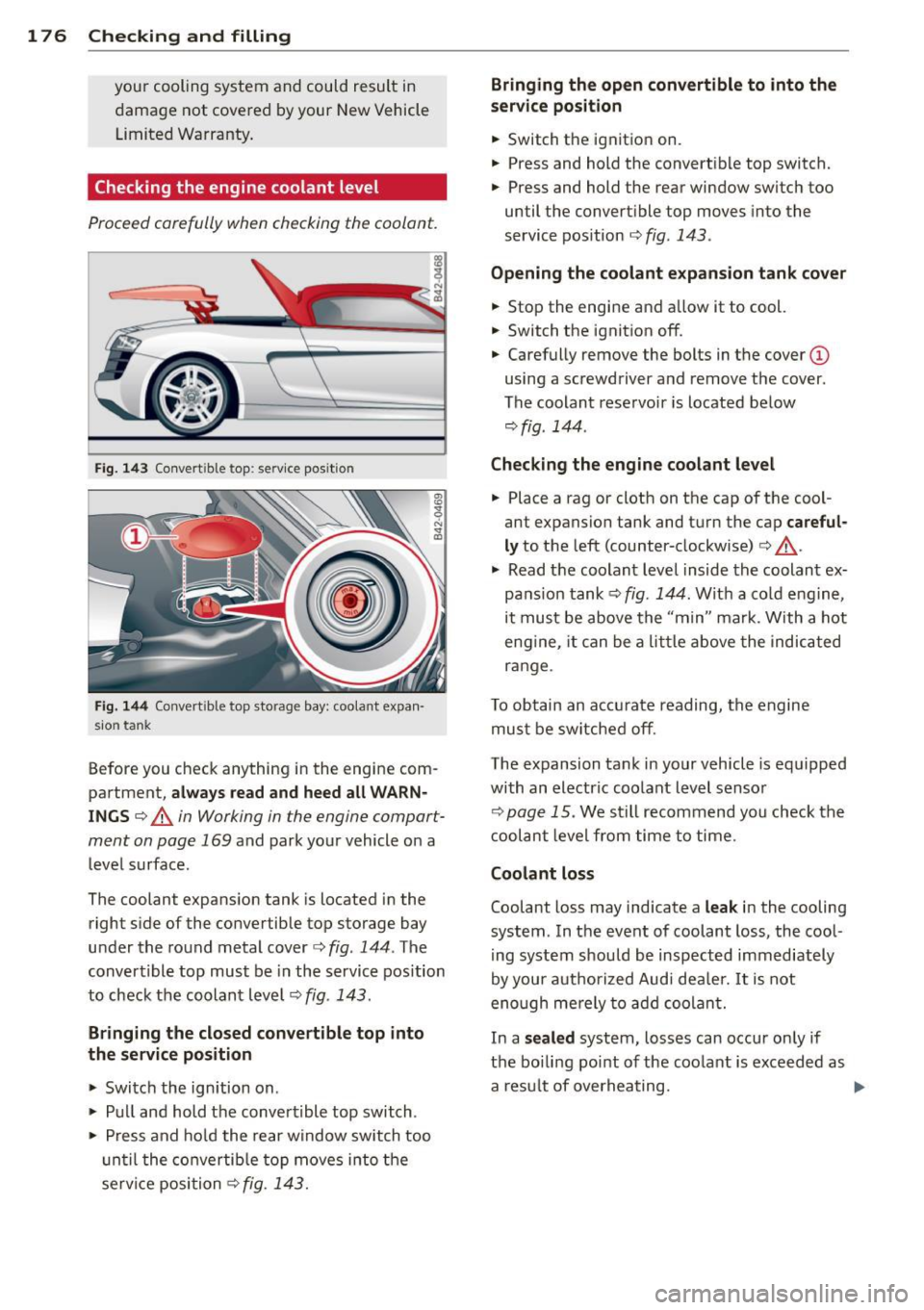
1 7 6 Che cking and filling
your cooling system and could result in
damage not covered by your New Vehicle Limited Warranty .
Checking the engine coolant level
Proceed carefully when checking the coolant.
Fig . 1 43 Co nvert ible top: se rv ice pos it ion
F ig . 14 4 Convert ib le top storage bay: coolant expan·
sio n tank
Before you check anything in the engine com
partment,
a lwa ys r ead and heed all WARN
INGS ¢.&.. in Working in the engine compart
ment on page
169 and park your vehicle on a
level surface .
The coolant expansion tank is located in the right s ide of the convertible top storage bay
under the round metal cover¢
fig. 144 . The
convertible top must be in the service position
to check the coolant leve l
¢fig . 143 .
Bringing the closed con ve rtible top into
th e s ervic e position
~ Switch the ignition on .
~ Pull and hold the convert ible top switch .
~ Press and hold the rear window switch too
u nti l the convertib le top moves into the
service position¢
fig. 143.
Bringing the op en conv ertible to into the
service position
~ Switch the ignition on.
~ Press and hold the convertible top switch.
~ Press and hold the rear window switch too
until the convertible top moves into the
service position¢
fig . 143 .
Opening the coolant e xpan sion tank cover
~ Stop the engine and allow it to cool.
~ Switch the ignition off.
~ Carefully remove the bolts in the cover (D
using a screwdriver and remove the cover.
The coolant reservoir is located below
¢fig. 144.
Chec king the engine cool ant level
~ Place a rag or cloth on the cap of the cool
ant expansion tank and turn the cap
careful
ly
to the left (counter-clockwise) ¢ .&_.
~ Read the coolant level inside the coolant ex
pans ion tank ¢
fig. 144 . With a co ld engine,
it must be above the "min" mark. With a hot
eng ine, it can be a little above the indicated
range.
T o obtain an accu rate reading, the engine
must be switched off.
The expansion ta nk in your vehicle is equ ipped
with an electric coo lant level sensor
¢page 15. We still recommend you check the
c oolant level from time to time.
Coolant loss
Coolant loss may indicate a leak in the cooling
system . In the event of coolant loss, the cool
i ng system shou ld be inspected immediately
by your aut horized Audi dea ler. It is not
eno ugh me rely to add coolant.
In a
s ea le d system, losses can occur on ly if
the boiling point of the coo lant is exceeded as
a resu lt of overheating.
Page 179 of 236
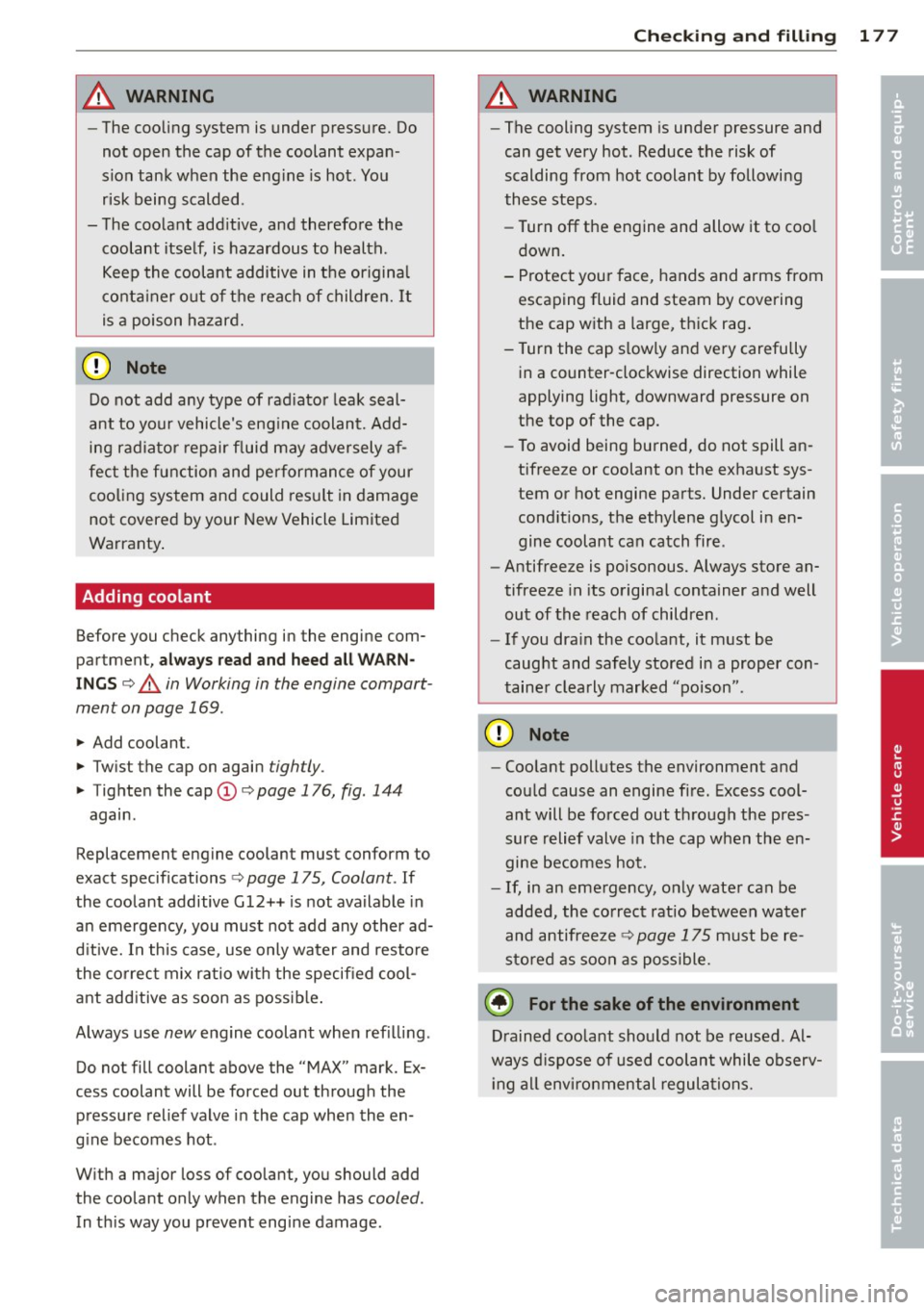
A WARNING ,~
- The cooling system is under pressure. Do
notopenthecapofthecoolantexpan
sion tank when the engine is hot . You
risk being scalded .
- The coolant additive, and therefore the coolant itself, is hazardous to health.
Keep the coolant additive in the original
container out of the reach of children. It
is a poison hazard.
(D Note
Do not add any type of radiator leak seal
ant to your vehicle's engine coolant. Add
ing radiator repair fluid may adversely af
fect the function and performance of your cooling system and could result in damage
not covered by your New Vehicle Limited
Warranty.
Adding coolant
Before you check anything in the engine com
partment,
always read and heed all WARN
INGS ¢ &. in Working in the engine compart
ment on page 169.
.. Add coolant .
.. Twist the cap on again
tightly .
.. Tighten the cap (D ¢ page 176, fig . 144
again.
Replacement engine coolan t must conform to
exact specifications ¢
page 175, Coolant . If
the coolant additive G12+ + is not available in
an emergency, you must not add any other ad
ditive. In this case, use only water and restore
the correct mix ratio with the specified cool
ant additive as soon as possible.
Always use
new engine coolant when refilling .
Do not fill coolant above the "MAX" mark. Ex
cess coolant will be forced out through the pressure relief valve in the cap when the en
gine becomes hot .
With a major loss of coolant, you should add
the coolant only when the engine has
cooled.
In this way you prevent engine damage .
Checking and filling 177
A WARNING
-The cooling system is under pressure and
can get very hot . Reduce the risk of
scalding from hot coolant by following
these steps .
- Turn off the engine and allow it to cool
down.
- Protect your face, hands and arms from escaping fluid and steam by covering
the cap with a large, thick rag.
- Turn the cap slowly and very carefully in a counter-clockwise direction while
applying light, downward pressure on
the top of the cap.
- To avoid being burned, do not spill an
tifreeze or coolant on the exhaust sys
tem or hot engine parts. Under certain
conditions, the ethylene glycol in en
gine coolant can catch fire .
- Antifreeze is poisonous. Always store an
tifreeze in its original container and well
out of the reach of children.
- If you drain the coolant, it must be
caught and safely stored in a proper con
tainer clearly marked "poison".
Q) Note
-Coolant pollutes the environment and
could cause an engine fire. Excess cool
ant will be forced out through the pres
sure relief valve in the cap when the en
gine becomes hot.
- If, in an emergency, only water can be
added, the correct ratio between water
and antifreeze ¢
page 175 must be re
stored as soon as possible.
@ For the sake of the environment
Drained coolant should not be reused. Al
ways dispose of used coolant while observ
ing all environmental regulations.
•
•